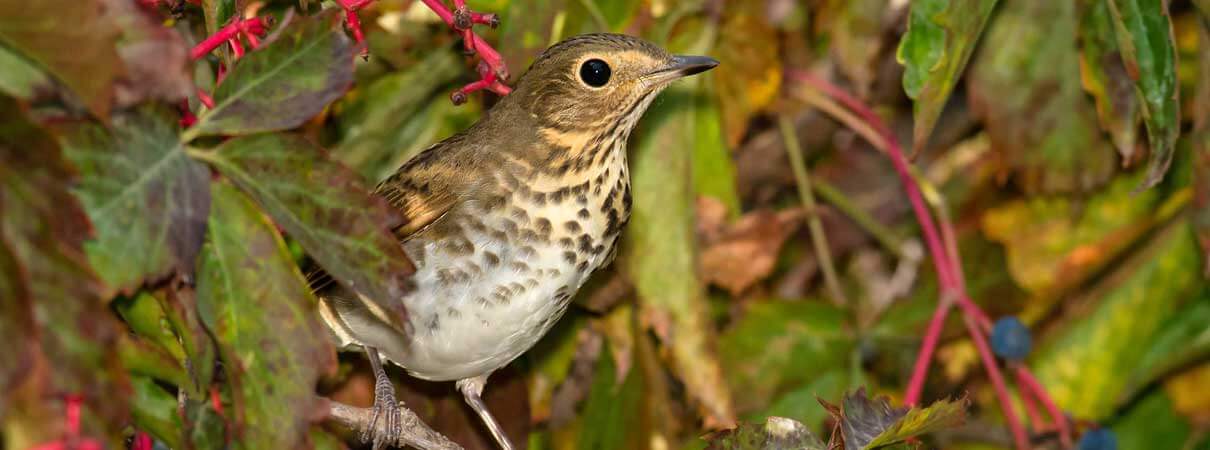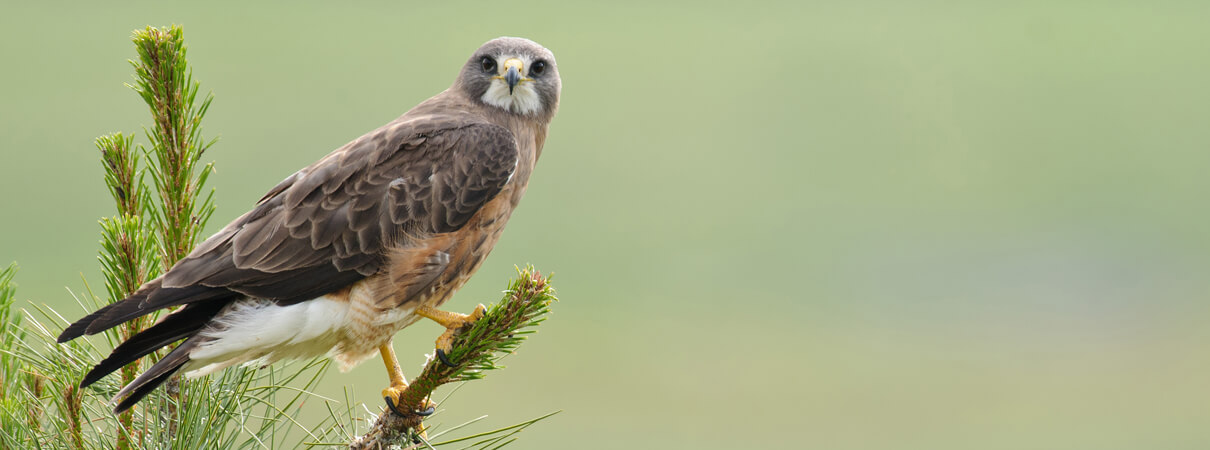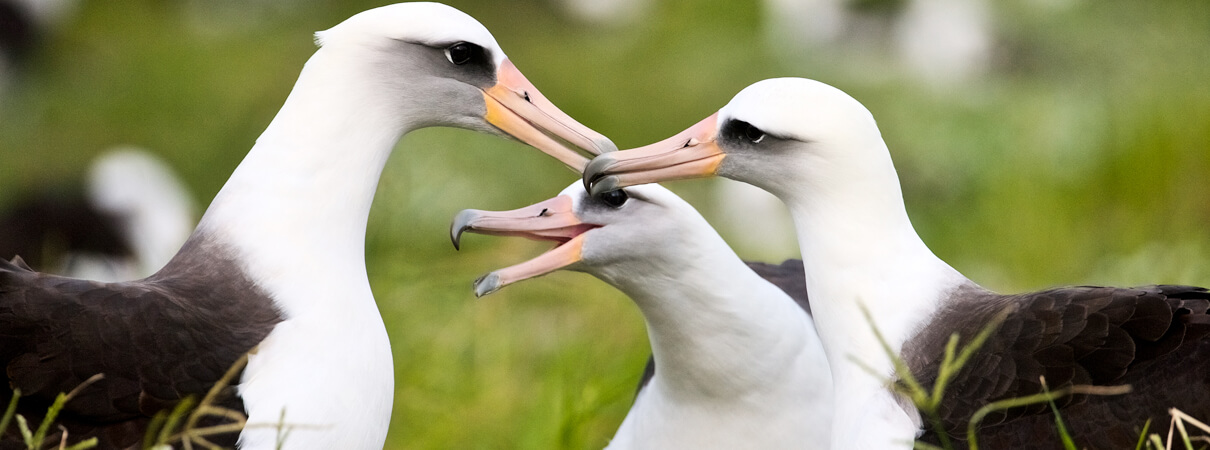Despite concern from the public, substantial challenges remain in reducing and mitigating many of the most significant sources of bird mortality.
Changes in lighting on communication towers and the marking of electrical lines to stop collisions are just two examples of what can be done at little cost to industry, but overall, bird concerns are still under-valued, and the bird community must unite to encourage and incentivize positive change.

Swainson's Thrush and other thrush species are frequent window collisions victims. Photo by Paul Reeves Photography/Shutterstock
Estimates indicate that the following threats each kill more than 500,000 birds per year in the U.S., and are not adequately mitigated or compensated:
ABC prioritizes its threat reduction work based on scale and urgency of threat, perceived opportunity for progress, whether others are already tackling the issue, whether we can provide special expertise or assistance, and whether sufficient resources are available.
We currently have a major program focus on reducing feral and owned cat predation, collisions with home and other building windows, and collisions with wind turbines.
We also have programs focused on pesticides and toxics (which kill about 72 million birds each year), collisions with power lines, collisions with communication towers, and mining claim marker tube entrapment.
Additionally, oil spills and fishery bycatch kill fewer (but still large numbers of) high conservation priority seabirds such as albatrosses, petrels, and murrelets.
(This table currently includes only mortality-based threats. Habitat-based and climate- related threats will be added in future as comparable impact data become available.)
Due to the large numbers and broad ranges involved, estimated changes in bird mortality due to conservation interventions are currently still too approximate to be especially useful. Still, we have made significant efforts to reduce bird mortality.
ABC's Cats Indoors campaign has slowed the rate of spread of feral cat colonies and has encouraged thousands of people to pledge to keep their cats indoors. We have also stimulated a change in the national conversation about the impact of cats on birds through social and traditional media coverage and other outreach efforts.

Modifications to glass make it more visible to birds, reducing the number of bird deaths due to window collisions. Photo by Paul Tankel
The reduction of bird collisions with window glass is a long-term effort, but the first critical steps by ABC to engage architects, glass manufacturers, and the public is well underway. Our Bird-smart glass page is one of the most-visited on the ABC website.
ABC's advocacy and outreach played a key role in the cancellation or restriction of 15 harmful organophosphate and carbamate pesticides, reducing bird mortality from toxic chemicals. However, our fight must continue given the advent and spread of deadly neonicotinoids.
ABC supports renewable energy, except when projects pose unacceptable risks to birds, such as along important migratory corridors or near protected areas. Our advocacy has helped to halt or mitigate at least 16 major wind development projects in these places
Large numbers of mining claim markers are being removed by volunteers and claim owners with encouragement from ABC and the Bureau of Land Management.
Bird mortality caused by lighted communication towers has almost certainly reduced significantly because of an ABC law suit and outreach that led to large numbers of towers changing to strobe lights that are less likely to lure birds to their deaths.
In addition to countering specific threats, ABC works to support overall federal funding for birds, to protect bedrock laws such as the Endangered Species Act and the Migratory Bird Treaty Act, and to support good — and oppose bad — legislation for birds.
A multi-agency partnership involving ABC reached a milestone in 2021 when the state of Hawai‘i approved permits for “Birds, Not Mosquitoes”— an all-out effort to reduce the primary threat to Hawaiian forest birds: avian diseases carried by the non-native insects.
ABC has communicated the cats indoors message to millions of Americans through social and traditional media. Since 2013, ABC has also intervened successfully on 26 state bills to protect birds from the expansion of ineffective cat management programs. In addition, in 2018, ABC and New York Parks Department reached a settlement in late 2018 to protect the Piping Plovers that nest at Jones Beach State Park by relocating feral cats to a sanctuary.
ABC has certified 125 glass and window mitigation products as bird-friendly, contributed to the establishment of a LEED credit for bird-friendly building design, and has trained more than 3,000 architects in bird-friendly design. ABC also opened a second testing facility in 2021 due to rising demand for bird-friendly glass.
Our work to reduce the greatest threats to birds was rewarded in 2019 with a major victory. The New York City Council passed a bill that requires the use of bird-friendly building materials in new construction and in major renovations across the city's five boroughs, where many hundreds of thousands of migrating birds die each year after colliding with glass. ABC staff played a key role by providing information to lawmakers over the last decade and testifying in support of the bill's passage. This is the most far-reaching bird-friendly building design legislation in the United States – and probably in the world. It provides a new model for how to make urban landscapes safer for birds.
ABC has advocated for the cancellation or restriction of 15 harmful organophosphate and carbamate pesticides, and launched a successful emergency campaign to protect Swainson's Hawks from monocrotophos poisoning in Argentina. After years of advocacy by ABC and its partners, the EPA issued a domestic food crop tolerance revocation on the dangerous pesticide chlorpyrifos. And, in 2017, ABC petitioned EPA to initiate a rulemaking restricting the use of neonicotinoid coated seeds to follow up on our groundbreaking 2013 study which found songbirds can die from eating a single coated seed.

Swainson's Hawk benefited when ABC and partners successfully stopped the use of deadly pesticides on their wintering grounds. Photo by Sarah Jessup/Shutterstock
With Earthjustice and the Forest Conservation Council, ABC won a lawsuit resulting in the Federal Communications Commission working to reduce bird mortality caused by the lighting on tall communication towers. Their policy now requires steady burning lights that attract birds to be replaced with strobes, reducing bird mortality by an estimated 70%. The transition is rapidly making progress, with 17% changing their lights to date. ABC has also fought specific tower construction proposals, including halting a tower close to Hawk Mountain Sanctuary, one of the worst possible locations in the U.S.
Renewable energy is vitally important in the fight against climate change—and it must be done in a way that limits impacts on already-declining birds and other biodiversity. Regarding wind energy, ABC has encouraged the adoption of mitigation strategies and has helped to halt or mitigate at least 16 major wind development projects. This includes the precedent-setting Heritage Wind project in New York, which was approved but required to remove or substantially mitigate its highest-risk turbines.
ABC filed and won a lawsuit to better protect eagles from wind turbine strikes by ensuring third-party oversight for eagle mortality monitoring. ABC filed a lawsuit with Black Swamp Bird Observatory that succeeded in halting a wind turbine project at Camp Perry, Ohio, in the epicenter of the greatest songbird migration corridor in the U.S. ABC helped to stop or modify seven additional wind developments in MO, ID, MD, VT, TX, and two Canadian provinces.
ABC and Black Swamp Bird Observatory together filed a legal complaint against the U.S. Department of Energy and Army Corps of Engineers over the agencies' failure to conduct a proper environmental assessment before approving and financing Icebreaker, the first offshore wind energy project in the Great Lakes. If it goes forward, the Icebreaker project would impact one of the greatest concentrations of migratory birds in North America. Renewable energy is vitally important in the fight against climate change. However, ABC insists that renewable energy be sited in such a way that impacts on birds can be minimized.
ABC is working with International Crane Foundation and industry partners to retrofit power lines in the Whooping Crane migration corridor to increase their visibility to migrating cranes.
ABC successfully advocated for the removal of lead paint from buildings on Midway that was poisoning Laysan Albatross chicks there, and, with Equilibrio Azul, helped develop new line-setting technology to protect Waved Albatrosses in Ecuadorian fisheries.

Laysan Albatross benefited from the removal of lead paint on Midway. Photo by Enrique Aguirre/Shutterstock
ABC successfully advocated for the inclusion of seabird protections in the Magnuson–Stevens Fishery Conservation and Management Act, and for albatross protection measures in U.S. Alaskan and Hawaiian longline fisheries that resulted in a c. 90% reduction is seabird bycatch.
ABC advocated for the Neotropical Migratory Bird Conservation Act and for its funding by Congress. The Act has provided $69.9M in grants to bird conservation projects since 2002, 75% of which conserved migratory birds outside the U.S. This allocation has benefited 4.75 million acres of bird habitat.
With Seattle Audubon, National Audubon Society, and Defenders of Wildlife, ABC filed a lawsuit that won protections for Caspian Terns in the Columbia River Estuary, Ore.